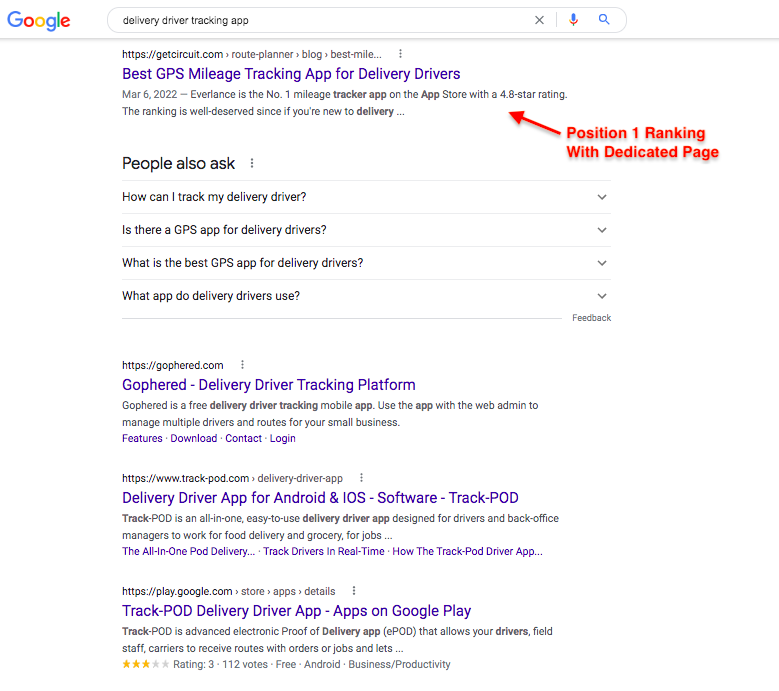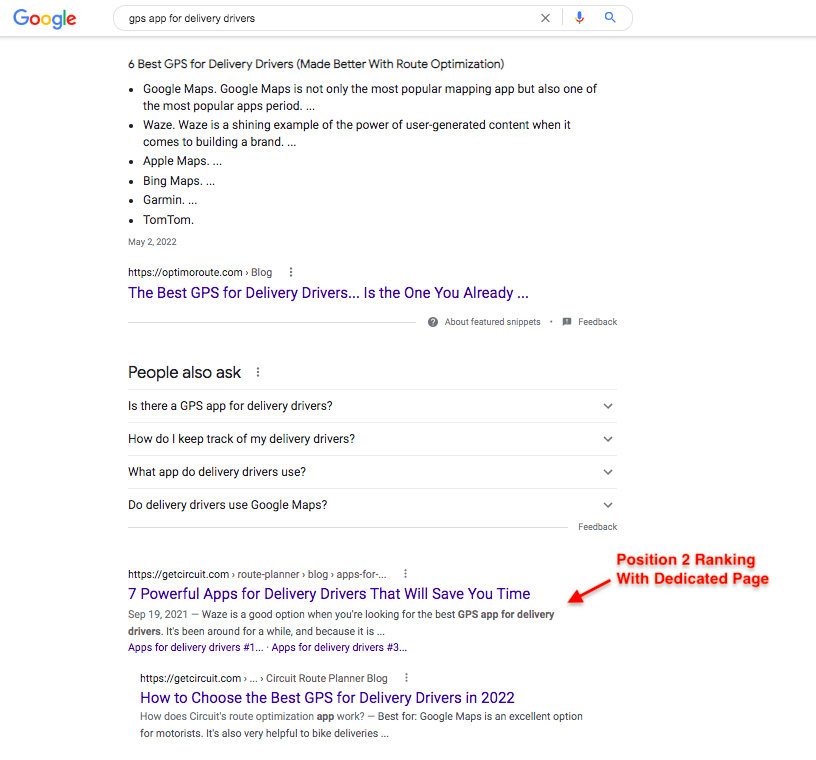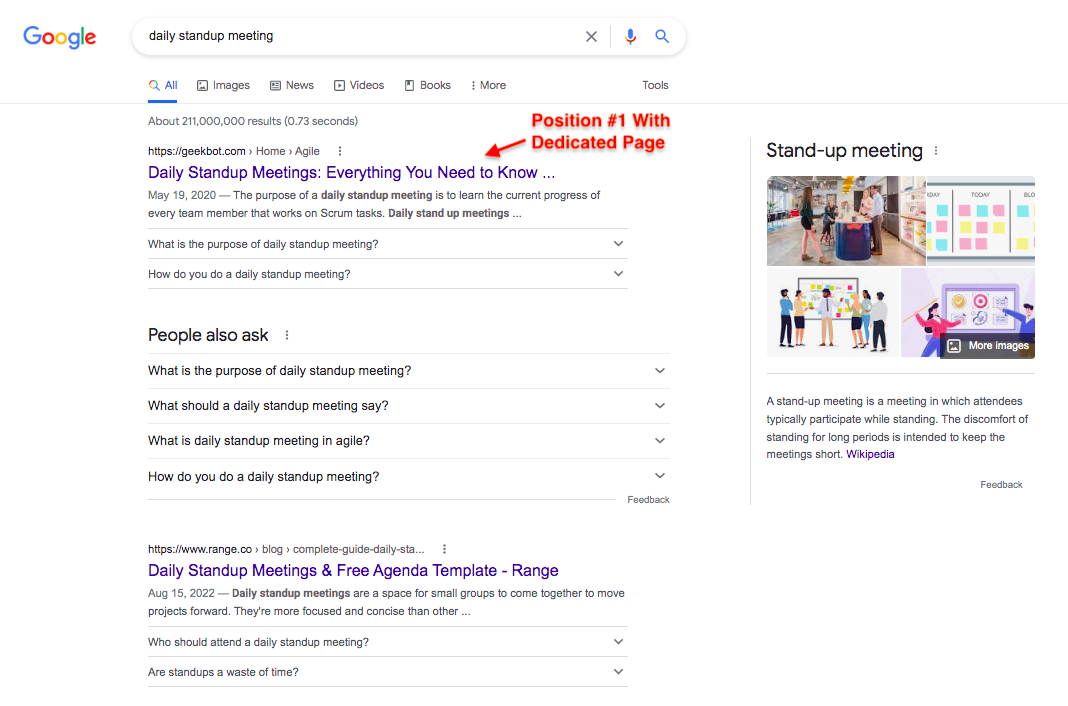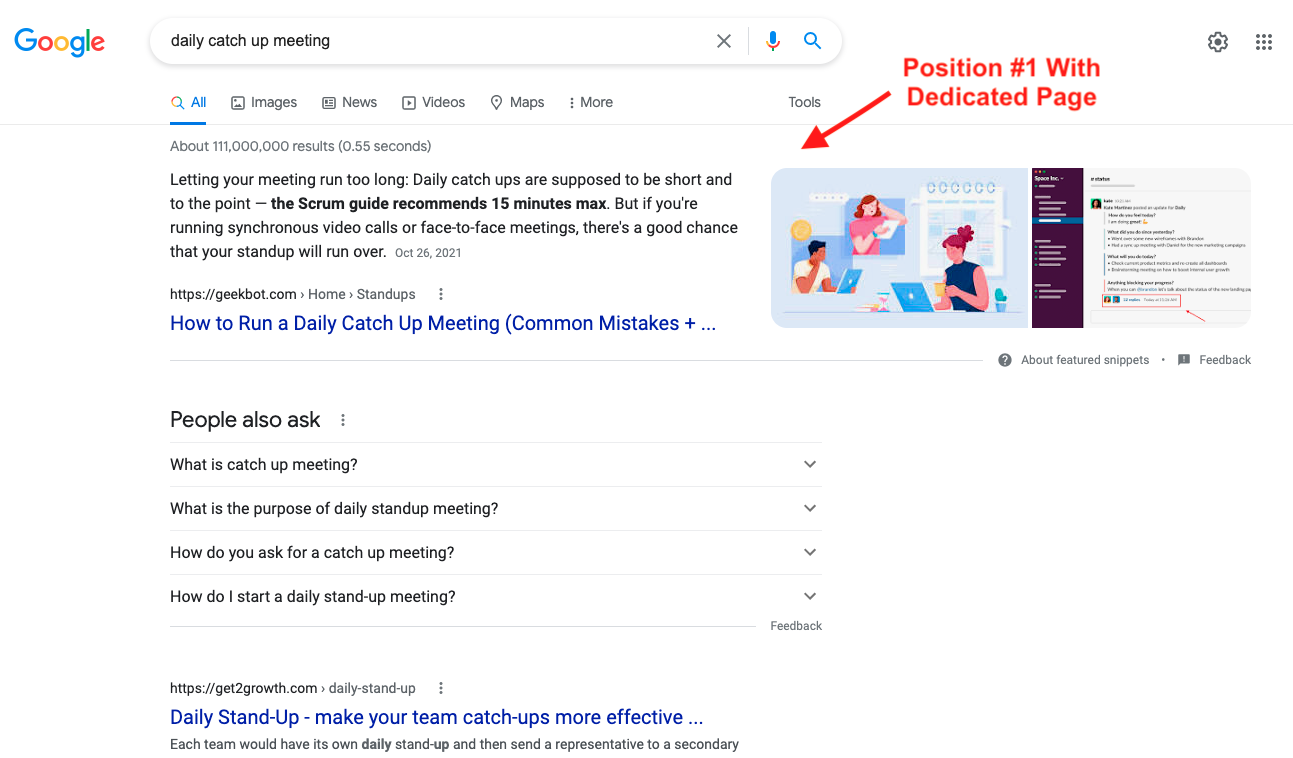An SEO content strategy is the process by which you choose the keywords you want to target and create content to target those keywords in order to drive leads, traffic, or a combination of the two.
In this guide, we share our step-by-step process (with detailed examples) for creating and maintaining a SEO content strategy that gives you the results you want.
While many of these steps may be similar to what you’ll find from other sources, there are common mistakes we’ve seen in how many marketers execute these steps. Because of these mistakes, many companies end up frustrated with the results of their content strategy and (often incorrectly) decide that SEO content marketing isn’t an effective channel for them.
We’ll cover what these mistakes are and how to avoid/fix them.
Curious about having us do content marketing for your business? You can learn more here.
If you’d like to learn the SEO content strategy we execute for our clients, we also teach our entire content creation process in our course and community.
Step #1: Be Extremely Intentional About Your SEO Content Goal (i.e., Traffic or Leads)
While this step may seem obvious, we’ve noticed that most marketing teams make the mistake of chasing traffic when they want to increase leads. However, if leads are your end goal, traffic is only a means to an end — it’s not the metric that you should use to rate the success of your SEO strategy.
On the other hand, traffic may be your goal if, for example, you’re already the brand leader in your space — e.g., Salesforce, Peloton, QuickBooks, or you’re in the middle of a series C round of funding on the path to an IPO and just want more exposure or mind-share. In that case, increasing website visitors via organic search is useful in and of itself.
Either goal is okay, the important thing is to be intentional about what your ultimate goal is because it has implications on your keyword strategy.
As we’ve demonstrated in our article on Pain Point SEO, keyword strategies that are designed primarily for driving traffic (i.e. keywords are selected based on which have the highest search volume) often produce very few leads. So, if your primary goal is to drive leads — or it’s at least a part of your goal — you’ll need a very different keyword strategy than the traffic-focused strategy that most SEOs employ.
Specifically, you’ll need to prioritize some or most of the keywords you target by purchase intent instead of search volume (i.e. prioritize keywords that indicate someone searching is on the market looking to buy the type of product or service you sell).
This is why we suggest companies first consider what their primary goal is from SEO. Again, there isn’t a right or wrong answer to what your goal should be. Just be aware that this is a decision to consider before you begin doing keyword research and developing your content plan.
Step #2: Identify Target Keywords That Will Drive Results for That Goal
Once you have your goal in mind, whether it’s traffic-focused, leads-focused, or a hybrid of the two, this should inform the keywords you choose to target.
Traffic-focused strategies will generally prioritize keywords that have higher search volume. These are typically what we call “Top of Funnel” keywords, where searchers are early on in the buyer’s journey — they typically have low purchase intent.
Again, a leads-focused strategy will prioritize keywords that have high purchase intent. These are what we call “Bottom of Funnel” keywords, where people searching are actively looking to buy.
To make this concrete, let’s look at some examples of keywords in each category through the lens of a B2B SaaS company we work with. They provide operational software for HVAC, plumbing, and electrical companies to run their day-to-day business.
Traffic-Focused Keyword Examples (Top of Funnel)
- HVAC business – 720 searches/month
- Electrician salary – 33,100 searches/month
- Plumbing leads – 720 searches/month
These terms have a relatively high monthly search volume for this space, and presumably some portion of these searchers would fall into our client’s target audience. For example, ownership or management of an electrician business could Google “electrician salary” to help guide how much they should pay their electricians.
However, the tradeoff is that because these keywords do not indicate the people searching are actively looking to buy software to help run their HVAC, electrical, or plumbing businesses, content targeting these search terms is unlikely to drive many leads for our client.
Leads-Focused Keyword Examples (Bottom of Funnel)
- HVAC software compatible with QuickBooks – 50 searches/month
- Electrical bidding software – 260 searches/month
- Plumbing invoice app – 50 searches/month
In contrast, these terms have lower search volume (often referred to as “long-tail keywords”) and will therefore drive less organic traffic compared to the higher volume keywords listed above.
However, because each of these terms indicate people are in buying-mode, searching for the type of product our client sells, conversion rates from content targeting these keywords will likely be much higher. (In our experience, keywords like these can often convert more than 10X higher than the ones above.)
If your primary goal from content is to generate leads, your content strategy should focus on targeting these types of keywords first. Depending on your product or service, the number of bottom of funnel keyword opportunities available to you will vary. But in general, a leads-focused strategy will go after as many of these keywords as possible before moving up the funnel.
If your primary goal is to drive traffic, you should focus on the higher search volume keywords like the ones we shared above. And if you want to use a hybrid strategy, you can target a mix of both types of keywords.
As we’ve mentioned, our agency’s strategy focuses on driving leads and product signups. We can drive traffic, too — as we’ve demonstrated in this case study. But we’ve found that most businesses want to see ROI from content, so this is our primary focus.
Here are some of our in-depth articles that explain exactly how we do this for a variety of business types:
- SaaS Businesses: How to Create a SaaS Content Strategy That Drives Product Signups
- B2C Businesses: B2C Content Marketing: A Guide to Drive Sales with Content
Now, once you’ve determined your goals and keyword strategy, there’s a second key factor, discussed next, that’s essential for the execution of that strategy (i.e. getting your content ranking for your desired keywords).
Step #3: Target Individual Keywords with Dedicated Pages
In the world of search engine optimization, there is a common practice of trying to target many related keywords with a single web page or piece of content. But as Google’s algorithm has evolved over time, this approach has become progressively less effective.
Fundamentally, the goal of a search engine is to provide the best possible answer to any given search query. And as a result, pages that are individually tailored to answer specific queries are beating out general pages which only briefly address or mention that query in addition to many others.
Furthermore, we’ve found that even when you’re targeting slightly different variations of nearly identical queries, you’re often more likely to get a top ranking position by creating separate, dedicated pages going after those terms.
As we discussed in our conversation with Bernard Huang of Clearscope, you only get one SEO title, one H1 heading, etc. — and these are key ranking factors for getting top positions.
To demonstrate this, here are two examples where we’ve used separate pages to rank for very similar terms for clients:
Example #1: “Virtual Daily Standup” and “Remote Standup”
Our client Geekbot makes a Slack app for remote teams to facilitate recurring “standup meetings.” We found that there are many keywords with search volume around the term “standup meetings” or “catch up meetings” — which are often used interchangeably.
Many companies would assume that terms like “daily standup meeting” and “daily catch up meeting” are so similar that a single piece on that topic should be created to try to rank for both. But instead, we created separate pieces of content for each of these keywords — focusing on the subtle differences in each keyword — and we’ve been able to get top ranking results for each query.
Here’s a screenshot of Google search results for the “daily standup meeting” variation where we’re in position #1:
Here’s a screenshot of search results for the “daily catch up meeting” variation where we rank in position #1 with a separate article:
Example #2: “Delivery Driver Tracking App” and “GPS App for Delivery Drivers”
Circuit makes route planning software for delivery drivers. Similar to above, by creating separate pieces of content for each variation, we were able to get top ranking positions for both keywords.
Here’s a screenshot of search results for “delivery driver tracking app” where we rank in position #1:

And here’s a screenshot of search results for “gps app for delivery drivers” where we’re ranking in position #2:

In both of these examples, it’s possible that we could have ranked on page one for both terms with a single article. However, in our experience, even if you can rank with a single article, it’s hard to get into the top 3 to 5 positions for different keywords.
This matters because the number of clicks received in those top 3 to 5 spots heavily outweighs the clicks received by results in the bottom half of the page. By creating separate pieces where the specific query is in the SEO title and various headings throughout the post, we were able to get top positions for both.
When this is applied at scale throughout a content strategy, it has a significant impact on overall results from SEO.
Applying This Approach in Practice
To apply this one-page-per-keyword approach in practice, you’ll add an additional step to your keyword research process. Specifically, when reviewing different variations of similar keywords, you should look at search results for each term. If there are different results showing up for each variation, then you’ll likely want to create a separate dedicated page for each of them.
Additionally, in cases where there are overlapping search results for each keyword, you’ll need to make a judgment call about whether to tackle the two variations with the same post or separate articles. You can see in the search results for the examples above, there are some overlapping results one page 1 in both keyword variations, but we chose to err on the side of creating separate pieces of content. As we demonstrated above, very often you’ll find that separate pages will give you the best shot at top ranking positions for both variations.
Other Steps for Executing an SEO Content Strategy: Content Writing, Link Building, and Measuring Results
Once you’ve developed a list of content topics and keywords to go after, there are a series of steps required to execute that content strategy. Namely, you need to write the content, build and generate backlinks to your content, and track your key metrics to measure results and monitor for potential issues.
In this section, we’ll discuss these at a high level and link out to past articles we’ve written on these topics for further detail.
Step #4: Write Quality SEO Content for Long-Term Results
There are a number of key things that companies get wrong when it comes to the actual writing of their content. Specifically:
- They work with freelance writers or agencies that lack processes for gaining and expressing subject-matter expertise through their content.
- They don’t think it’s okay to sell or talk about their product in their content.
- They just “sprinkle” keywords into their content and think that will be sufficient to rank.
These issues lead to generic, low quality content. And simply sprinkling keywords into a page will not get it to rank.
Effective content writing for SEO takes a much more strategic approach. You need to do in-depth SERP analyses, craft outlines with the right subtopics and subheadings, and fill those outlines in with compelling, high-quality content.
We’ve documented our process for doing each of these things which you can read about here. In that piece, we cover:
- Topic: Come up with content ideas and identify target keywords that have business value.
- SERP Analysis: Analyze the search engine results page (SERP) for each of those keywords to understand: (a) Which topics need to be covered in your article for it to rank and (b) Which types of content are getting top spots — e.g. List posts? Product landing pages? “How to” articles? Templates?
- Structure: Choose the angle and structure of your article based on that SERP analysis.
- Writing: Write the content in a way that fills in that structure with compelling information to sell your product or service.
- On-Page SEO: Polish off your content with on-page SEO and write your meta description.
Step #5: Build Links to Drive Results in Short-term
In our opinion, many people try to shortcut the content writing process by building a ton of links to their content. They think that they can just spend a lot of money on link building and drive results regardless of their content quality or how well they address search intent.
But in our experience, 80% of what drives results from SEO content is the process we mentioned above: picking the right keywords, strategically structuring articles, incorporating subject-matter expertise, selling the product, etc. The other 20% is made up by link building.
We do link building for our clients through partner agencies and have found it to be helpful for improving rankings on a keyword-by-keyword basis, after you’ve followed the writing process outlined above. It’s used as a supporting element to get rankings — not as the main driver of results.
In addition to building external backlinks, we also include internal links within articles to other relevant content on our client’s site. This is another best practice that supports overall SEO results.
Step #6: Measure Traffic, Keyword Rankings, and Conversions
Finally, we track and report on a variety of metrics for our clients with the following tools:
- Conversions: We track and report on conversions using the Model Comparison Tool in Google Analytics.
- Keyword Rankings: We use Ahrefs rank tracker to monitor rankings progress for each article’s target keyword. (You could also use Semrush, Google Search Console, etc.)
- Overall Pageviews and Organic Traffic: We set up traffic dashboards in Google Data Studio that measure overall pageviews and organic traffic to our articles.
The most notable of these three is conversion tracking. Most content teams (in house or agencies) don’t hold themselves accountable to leads generated from content. In fact, most don’t even report on this. But without conversion data, you are essentially conceding that your content strategy is traffic focused (because everyone tracks traffic).
Check out our article on content marketing attribution to learn more about how we measure conversions from content.
Want to Work with Us or Learn More About How We Approach Content Marketing?
- Our Agency: If you want to hire us to execute content marketing in this way, you can learn more about working with us here.
- Join Our Team: If you’re a content marketer or writer and would love to do content marketing in this way, we’d love to have you apply to join our team.
- Our Content Marketing Course: Individuals looking to learn our agency’s content strategy and become better marketers, consultants, or business owners can join our private course, taught via case studies, and presented in both written and video content formats. We include several details and examples not found on this blog. Our course is also built into a community, so people ask questions, start discussions, and share their work in the lesson pages themselves, and we, along with other members, give feedback. Learn more here or watch this video walkthrough:










